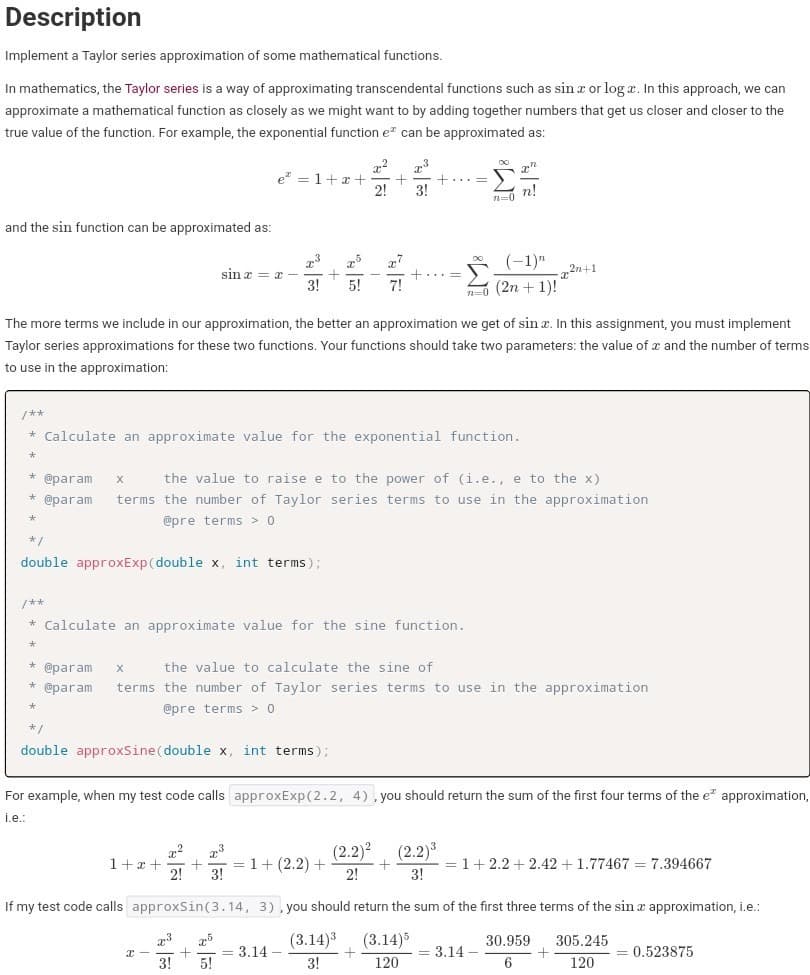plement a Taylor series approximation of some mathematical functions. mathematics, the Taylor series is a way of approximating transcendental functions such as sin z or log æ. In this approach, we c proximate a mathematical function as closely as we might want to by adding together numbers that get us closer and closer to ti e value of the function. For example, the exponential function e" can be approximated as: e = 1+x+ 2! +.. 3! d the sin function can be approximated as: (-1)" sin z = a 3! 2 2n+1 (2n + 1)! 5! e more terms we include in our approximation, the better an approximation we get of sin z. In this assignment, you must implem ylor series approximations for these two functions. Your functions should take two parameters: the value of a and the number of use in the approximation: /** * Calculate an approximate value for the exponential function. * eparam the value to raise e to the power of to the .e., * @param terms the number of Taylor series terms to use in the approximation @pre terms > 0 double approxExp(double x, int terms); /** IM:
plement a Taylor series approximation of some mathematical functions. mathematics, the Taylor series is a way of approximating transcendental functions such as sin z or log æ. In this approach, we c proximate a mathematical function as closely as we might want to by adding together numbers that get us closer and closer to ti e value of the function. For example, the exponential function e" can be approximated as: e = 1+x+ 2! +.. 3! d the sin function can be approximated as: (-1)" sin z = a 3! 2 2n+1 (2n + 1)! 5! e more terms we include in our approximation, the better an approximation we get of sin z. In this assignment, you must implem ylor series approximations for these two functions. Your functions should take two parameters: the value of a and the number of use in the approximation: /** * Calculate an approximate value for the exponential function. * eparam the value to raise e to the power of to the .e., * @param terms the number of Taylor series terms to use in the approximation @pre terms > 0 double approxExp(double x, int terms); /** IM:
Computer Networking: A Top-Down Approach (7th Edition)
7th Edition
ISBN:9780133594140
Author:James Kurose, Keith Ross
Publisher:James Kurose, Keith Ross
Chapter1: Computer Networks And The Internet
Section: Chapter Questions
Problem R1RQ: What is the difference between a host and an end system? List several different types of end...
Related questions
Question
Don't put up wrong answer. I already got wrong answer of this question.
Do code attach screenshot of code so that it will help me to understand

Transcribed Image Text:Description
Implement a Taylor series approximation of some mathematical functions.
In mathematics, the Taylor series is a way of approximating transcendental functions such as sin x or log x. In this approach, we can
approximate a mathematical function as closely as we might want to by adding together numbers that get us closer and closer to the
true value of the function. For example, the exponential function e" can be approximated as:
73
e" = 1+x +
2!
3!
- nl
and the sin function can be approximated as:
(-1)"
73
sin z = x -
3!
„5
77
2n+1
(2n + 1)!
5!
7!
n=0
The more terms we include in our approximation, the better an approximation we get of sin x. In this assignment, you must implement
Taylor series approximations for these two functions. Your functions should take two parameters: the value of x and the number of terms
to use in the approximation:
/**
* Calculate an approximate value for the exponential function.
@param
the value to raise e to the power of (i.e., e to the x)
* @param
terms the number of Taylor series terms to use in the approximation
@pre terms > 0
*/
double approxExp(double x, int terms);
/**
* Calculate an approximate value for the sine function.
* @param
the value to calculate the sine of
@param
terms the number of Taylor series terms to use in the approximation
@pre terms > 0
*/
double approxSine(double x, int terms);
For example, when my test code calls approxExp(2.2, 4), you should return the sum of the first four terms of the e approximation,
i.e.:
1+x +
2!
(2.2)?
= 1+ (2.2) +
2!
(2.2)3
= 1+2.2 + 2.42 +1.77467 = 7.394667
3!
3!
If my test code calls approxSsin(3.14, 3) , you should return the sum of the first three terms of the sin a approximation, i.e.:
73
(3.14)3
(3.14)5
30.959
305.245
= 3.14 –
5!
= 3.14
0.523875
3!
3!
120
6
120
Expert Solution
This question has been solved!
Explore an expertly crafted, step-by-step solution for a thorough understanding of key concepts.
Step by step
Solved in 3 steps with 3 images

Recommended textbooks for you

Computer Networking: A Top-Down Approach (7th Edi…
Computer Engineering
ISBN:
9780133594140
Author:
James Kurose, Keith Ross
Publisher:
PEARSON

Computer Organization and Design MIPS Edition, Fi…
Computer Engineering
ISBN:
9780124077263
Author:
David A. Patterson, John L. Hennessy
Publisher:
Elsevier Science

Network+ Guide to Networks (MindTap Course List)
Computer Engineering
ISBN:
9781337569330
Author:
Jill West, Tamara Dean, Jean Andrews
Publisher:
Cengage Learning

Computer Networking: A Top-Down Approach (7th Edi…
Computer Engineering
ISBN:
9780133594140
Author:
James Kurose, Keith Ross
Publisher:
PEARSON

Computer Organization and Design MIPS Edition, Fi…
Computer Engineering
ISBN:
9780124077263
Author:
David A. Patterson, John L. Hennessy
Publisher:
Elsevier Science

Network+ Guide to Networks (MindTap Course List)
Computer Engineering
ISBN:
9781337569330
Author:
Jill West, Tamara Dean, Jean Andrews
Publisher:
Cengage Learning

Concepts of Database Management
Computer Engineering
ISBN:
9781337093422
Author:
Joy L. Starks, Philip J. Pratt, Mary Z. Last
Publisher:
Cengage Learning

Prelude to Programming
Computer Engineering
ISBN:
9780133750423
Author:
VENIT, Stewart
Publisher:
Pearson Education

Sc Business Data Communications and Networking, T…
Computer Engineering
ISBN:
9781119368830
Author:
FITZGERALD
Publisher:
WILEY